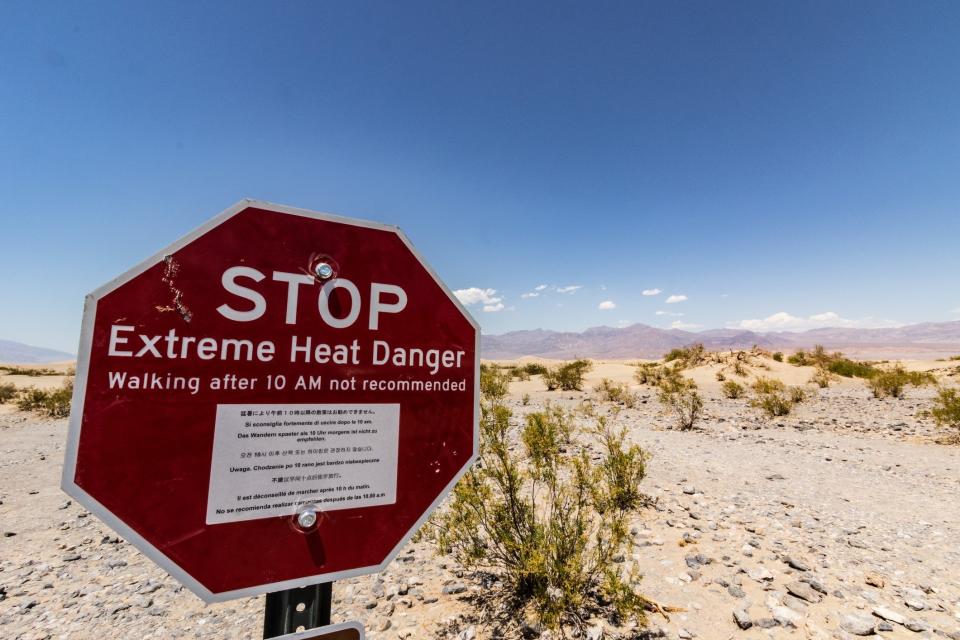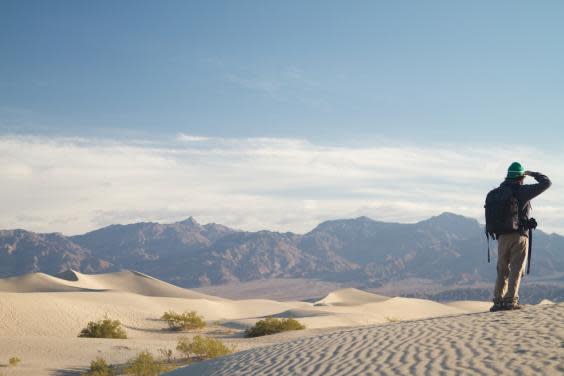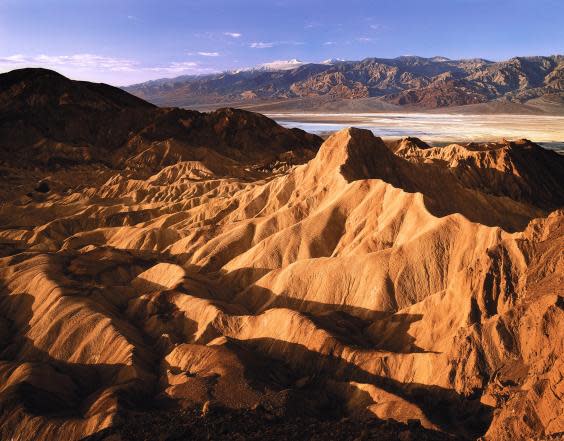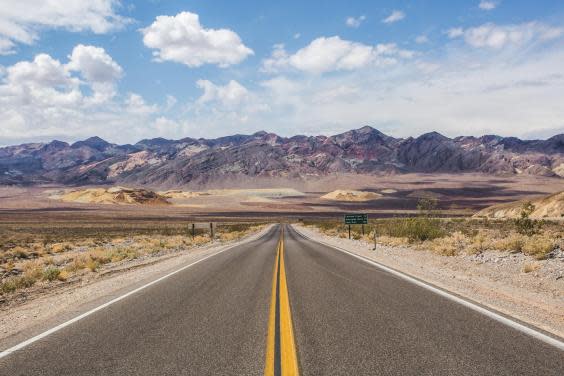Exploring Death Valley, North America’s most misunderstood national park

Eleven o’clock overlooking Zabriskie Point, and I have 1,700 million years of desert to myself. The heat bounces off the lava-eroded rocks and I’ve paused in front of a no-nonsense sign while clambering up to the panorama.
“Stop: Extreme Heat Danger,” it reads in alarming white on emergency red. “Walking after 10am not recommended.” Suddenly the question that haunts me is: which morgue will I end up in if I ignore the advice?
Despite the disorientating name, the reputation as the hottest, driest place on earth, the wildlife with teeth, claws and fangs, and the fact it doesn’t give a damn about you, there is something life-affirming about Death Valley. It is a dream-like band of surreal golden hills, slivery canyons, sand dunes and salt flats between the High Sierras and Nevada, and its morphed geography marks the changing of time: this is where almost all human life fades away.
Turn to the east, and you are confronted by the casinos and craziness of Las Vegas; turn west, and you reach the magnificent forest groves of Yosemite, King’s Canyon and Sequoia national parks, nowadays swarmed by campers, camper vans and motorhomes. The untamed, otherworldly badlands, empty by comparison, are silent and still.
Increasingly, transatlantic travellers are looking beyond the more well established Grand Canyons and Yellowstones, in search of somewhere a little different. And few places are as wild – or satisfyingly surreal – as Death Valley. Tourism is in its infancy here and the timing is right for a visit, too. Last autumn it proudly celebrated 25 years as a national park and there’s more good news forthcoming. Bill Clinton signed the California Desert Protection Act on 31 October 1994, upgrading Death Valley from a national monument and adding 1.3 million acres to its expanse, and now President Trump is an unlikely cameo in the park’s current narrative. In a rare conservation success story under his administration, the US president has signed off legislation to further protect Death Valley’s wildlife habitats, swelling its borders by an additional 35,000 acres. This realisation further cements the park as the largest swathe of contiguous protected wilderness outside Alaska.

“If a desert is the land of extremes, then we’re the extreme of extremes,” says Renee Rusler, a 20-year park service veteran and my guide later that afternoon. Death Valley will never lose its ability to surprise us because, as she puts it, it can make visitors feel enchanted and anxious, excited and unsettled, all at the same time: “In moments it can instantly turn from wasteland to wonderland.”
I’ve come in early June, the mercury hovering around 44C, so we seek refuge in the air-con cool of my hire car and make for Badwater Basin, North America’s lowest point at 86m below sea level. Outside, the earth at the roadside is dust-dry, the shrubs bare-branched. The environment is so denuded I wonder if there is anything to see at all until we pass an 18-hole golf course and the Furnace Creek Stables offering carriage and trail rides. The sun is never on holiday here, so such sacred holiday rituals at least make some sense, and soon we’re passing road signs pointing to Golden Canyon and Artists Drive – spectacular, hulking gulches used as locations for Tatooine in Star Wars and Return of the Jedi.

Not that you’d know it, but after walking across the seemingly-infinite salt pans of Badwater Basin, I’m told there is plenty of wildlife higher up among the park’s swathes of bristlecone pines. Desert-happy mountain lions, bobcats, coyotes and king snakes all seek shelter from the searing sun and yet these ghosts of Death Valley remain entirely elusive. Primarily because 90 per cent of the park’s momentous 3.4 million acres – an area bigger than Jamaica – remains true, inaccessible wilderness.
Tonight, I’m sleeping at the newly renovated £140m Inn at Death Valley, a desert Xanadu with a view looking right into the centre of the Milky Way. The Spanish mission-style hotel, with spring-fed pool and sugarcube-like casitas, is akin to an oasis on the moon, but with comfy bedrooms and a double hit of freezer-fresh air-con units and fans. There are even outdoor fireplaces for cold desert nights. But the magic of the place is not that it is here in the first place. It is the aura of golden-era movie nostalgia carried from front desk to saloon bar to restaurant. In its heyday, as grainy movie star pictures show, the resort attracted John Wayne, Clark Gable and Carole Lombard, James Cagney and Bette Davis. Jimmy Stewart and Marlon Brando stayed here, too.

When the sun appears next morning, the light reflecting the faraway escarpments in the woozy salt pans, I rise to hike to Dante’s View. Located on the north side of Coffin Peak (see also the ghoulishly named Last Chance Range, Deadman Pass and the Funeral Mountains), it reveals a hypnotically beautiful landscape of golden-lit basins, creeks and peaks and is so-named after Dante Alighieri, who described the nine circles of Hell in The Divine Comedy. I feel no morbid curiosity. Nor see a scruffy wasteland. All I see is summer loveliness.
This is what Death Valley is all about. Yes, it’s a kind of spiders-in-shoes sort of place. Yes, there are alarming signs designed to scare you (“Heat Warning! Don’t forget your water! Sunblock! Water! Hat! Water!” reads one such memorably excessive info board at the visitor centre). But even though a Death Valley visit can sound downright daunting, it’s a place of riotous and unequalled colour, a miraculous encounter between man, land, and time, and a ridiculously easy way to discover California at its most extreme. What better way to feel alive than that?
Travel essentials
Getting there
Virgin Atlantic flies to Las Vegas from London Heathrow and Manchester from £368 ($461). JetBlue, Spirit Airlines, Delta, United and Frontier Airlines serve Las Vegas from a number of US destinations.
Death Valley National Park is a 2hr 25min drive from Las Vegas.
Staying there
Doubles at The Inn at Death Valley from £319 ($417), B&B.

 Yahoo News
Yahoo News 